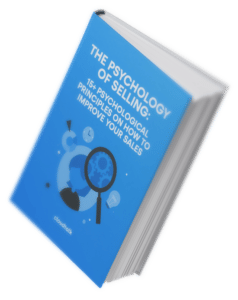What is a Sales Call? 8 Proven Ways to Improve your Sales Efforts

It may surprise you to learn that calls are still king when it comes to customer interactions, as 92% of them are conducted over the phone. The majority of deals begin over the phone, and most of them end this way too. It is a popular way to get in touch with clients, and if used wisely, can be very profitable.
So what exactly is a sales call and how can you get better at them? Let’s find out.
What is a sales call?
A sales call is a meeting between a salesperson and a prospect. It is a pre-arranged conversation and its main goal is to finalize a sale. These meetings are crucial because first impressions are made only once. Sometimes it may be the only chance to chat with a prospect and tell them about your offer.
Furthermore, the main goal of a sales call is to define the prospects’ needs and how your company can meet them. But it is not that easy to gather so much information. To make a sales call effective, you need to be well-prepared and provide good background for such a conversation. Keep reading to find out how.
How to structure a sales call
There are seven steps in total for making a sales call, and the first of them starts before the first Hello.
Step one: Preparation
Preparation is essential for making successful sales calls. For conversations to feel natural and professional at the same time, you should know what to expect and who exactly your future client is.
First things first, do your research. Learn about the prospect’s business, their targets, needs, and past collaborations. Next, ask yourself what their business goal is, define it clearly, and keep it in mind during the conversation. Then prepare your sales pitch and be ready to present it at any time in the best possible way.
Furthermore, in order to determine all the information you need, you should make a list. Having it in writing will be more convenient, and once you finish discussing one topic, you can check if you need to know something else. You could also write down some numbers or statistics about your company or relating to the topic. Knowing such details will help you make the call more professional.
Step two: Greeting
The basic rule is just to be polite and soften your voice as much as possible. You need to be open to dialogue and listen more than you speak. From the very start, you need to sound friendly. Start by saying Hi and introducing yourself; your name, job position, and the company you are calling from. You should ensure that your prospect has time for the conversation and that you aren’t disturbing them. Once you are sure that you’re not bothering your prospect, you can start asking some questions and slowly getting to the point.
Step three: Qualifying
Qualifying is all about assuring the prospect about what you know and diving deep into a topic. You should establish the exact problem and whether or not they have tried to solve it before. Some other questions you should ask include
- What solutions have you tried before and when?
- If not, what has prevented you from trying to solve the problem until now?
- Do you have a budget for solving this problem?
- Are you evaluating any other solutions and, if so, what are they?
- Who are the decision-makers?
- Do you have a time frame for resolving this issue?
- What is the usual process during which the problem occurs?
These form a good opening for a longer, more in-depth conversation.
Step four: Surveying
During this stage, you should get to know the company better. What are their goals, plans, etc? Don’t hesitate to ask as many questions as you need. The more you know, the better the collaboration can be. You should for information such as:
- Their short-term and long-term goals.
- The next steps for this collaboration and an approximate schedule.
- Expectations regarding the salesperson’s role.
- Thoughts about your company.
- The prospects’ role in their company and its structure.
The more questions you ask, the more clarified the picture of the company you will get. And thus you will be able to solve the problem more efficiently. Focus on open-ended questions like what, when, and how? This gives your prospect room for maneuver and the ability to describe the situation and their business in detail.
Step five: Handling objections
Now it’s time to listen. The prospect may have their doubts and questions. It is always better to clarify. Listen and answer all of their questions and objections. Give them a reason to work with you. Remember to answer politely without interrupting the person on the other end of the line.
Step six: Presentation
It is showtime! It’s your five minutes of glory, so do your best to present the solution in the most professional and persuasive way you can. Show that you recognize the client’s needs via your presentation and give an overall overview of the solution you have prepared. Focus on the benefits and involve your client in the presentation. Remember to sum up at the end and highlight how you can meet all of their needs and requirements.
Step seven: Closing
How you end the conversation is just as important as the way you start it. The last impression you make will stay with your client for a long time. Before you hang up, you need to be sure that all questions have been answered and all doubts expelled. Finally, summarize where you have ended up. Furthermore, it is essential to maintain communication; how will you stay in touch? Follow-up calls, e-mails, or face to face meetings? It is the right time to ask about referrals too.
Sales call tips
Since you know what the sales call structure is, it’s high time to share some useful tips for making the most of them. Below you will find 8 pieces of advice to master sales calls.
Observing the human mind is a great way towards scaling your business

Use great call center software
It is hard to do your job well without decent tools. Before you make a call, be sure you use reliable call center software. What does reliable mean in practice? Great call center software should make agents’ work easier. For example, you can use the click to call feature to make it easier for your agents to start a new call. Moreover, making notes about each client or splitting them into smaller groups to keep all information in order can be very useful. Also, when it comes to making notes, a speech-to-text feature helps with that. All conversations can transform into text, which facilitates searching for information.
We have great news – CloudTalk ticks all the boxes and offers even more than the features mentioned above.
There are four plans to choose from, and each of them has a free trial for you to give CloudTalk a try.
Integrate popular business apps (such as CRMs)
Integrating your business app could be a real gamechanger. It makes workflow seamless by simplifying many tasks. You need to integrate your software with the programs and apps you use on a daily basis. Moreover, integrating apps with one another and your CRM allows each agent to have a comprehensive overview of every client. If you as an agent can manage all data from the CRM, sales call preparation will only take you minutes and creating a solution for the prospect won’t be a tough nut to crack.
Personalize the call with data from your CRM
Once you integrate apps with your CRM, make the most of it. Make the call as personalized as possible by using all the information you can find there. Furthermore, many popular CRM systems allow you to analyse a client’s performance and their history so you can predict their questions and come up with a solution before the call even starts.
Use a script and refine it over time
Having a script on hand helps with various types of calls. It provides you with scenarios that you can follow, and it gives you a hand every time you lose your flow. It is important to not follow the script too strictly, as you should sound as natural as possible. Moreover, each script can be refined. Eventually, you’ll notice which problems usually go unnoticed and which ones cause the most emotions. Make some adjustments in order to keep the script useful and relevant.
Make it a dialogue rather than just the agent talking
A sales call should be a conversation. Yes, it is you who presents the solution, but you should talk with your prospect in order to identify their doubts or questions. Do not over talk and allow the other side to give their point of view. This way, both of you will feel fulfilled and content with the way the conversation goes.
Ask the right amount of questions
This goes hand in hand with the tips above. Ask questions and wait for the answers. Moreover, do not ask too many; it is not an interview or investigation. You want to gather information, but enough is enough; your main goal is to make your prospect feel comfortable. Covering 3-4 issues would be perfect, as this gives you space to ask about 11-14 questions. Also, it works both ways – two questions are not enough to get to know the other side. A too short of a list of questions can be seen as an unprofessional approach and a lack of interest from your side.
If you’re on a video call, turn on your camera
If your sales conversation is a video one, it is not a good idea to speak when the camera is turned off. It is unprofessional and rude. It is hard to speak to a black window on the screen or a tab with the speaker’s name. The purpose of video calls should be to make conversations friendly and open, but such behaviour does not allow that. Moreover, remember to check your microphone (whether it is muted or not) and wait until the prospect stops speaking. Otherwise, both of you won’t get anything from the conversation because you will talk over each other.
Discuss the value and show your offer as an investment rather than a cost
You need to present the solution as a great benefit and value that could bring a breath of fresh air to the company. Of course it will cost them, but investment is more persuasive. The language of benefits should be used. Focus on presenting value to the company and showing how much of it your solution can bring.
Conclusion
Sales calls can be a crucial part of your company’s sales strategy, provided they are made in the right way and using our tips! This article can help you fully understand what sales calls are, what steps you need to follow, and how to deliver them effectively.
When it comes to such calls, practice makes perfect. The more calls you make, the more natural you will sound and the less likely you are to be surprised by anything during your meetings.
























